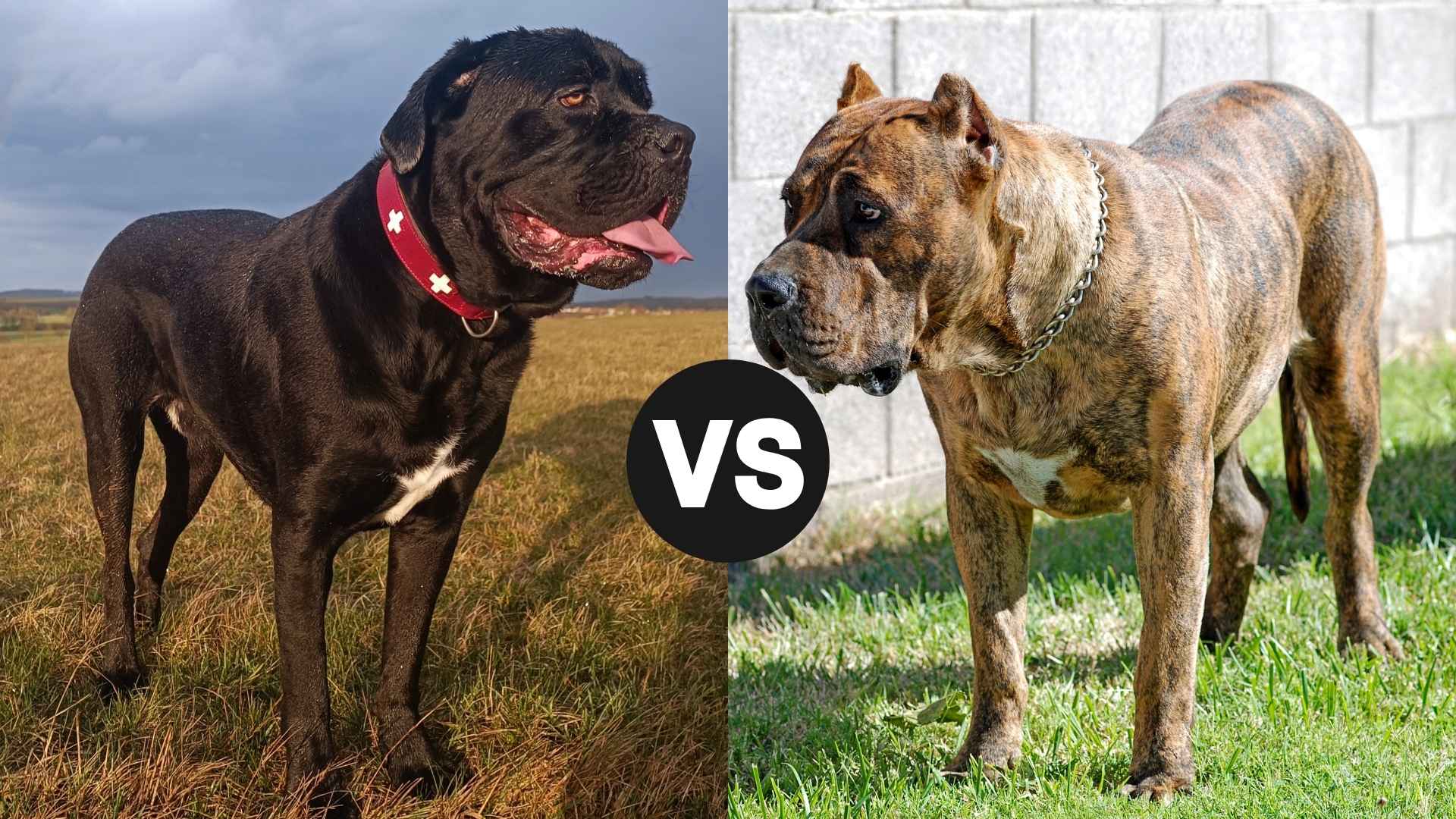The Cane Corso and Presa Canario are two massive, powerful breeds that often get mixed up. At first glance, they look alike—strong, muscular, and built for protection. But if you dig a little deeper, you’ll see they have distinct personalities, histories, and training needs that make them unique.
The Cane Corso is a top contender if you’re after a loyal, intelligent guardian. This breed thrives on structure, bonds deeply with its family, and has a strong work ethic. Meanwhile, the Presa Canario is a confident, dominant protector with an instinct for guarding livestock and property. Both are not for the faint-hearted—they need an owner who can handle a strong-willed dog.
So, which one suits your lifestyle? Let’s break down their temperament, training demands, and key differences so you can decide which powerhouse is the right fit for you!
Cane Corso vs. Presa Canario
Cane Corso and Presa Canario may look similar at first glance, but they have distinct differences in temperament, training needs, and overall build. The Cane Corso is more agile, athletic, and eager to please, making training relatively easier, while the Presa Canario is more independent, dominant, and requires an experienced handler.
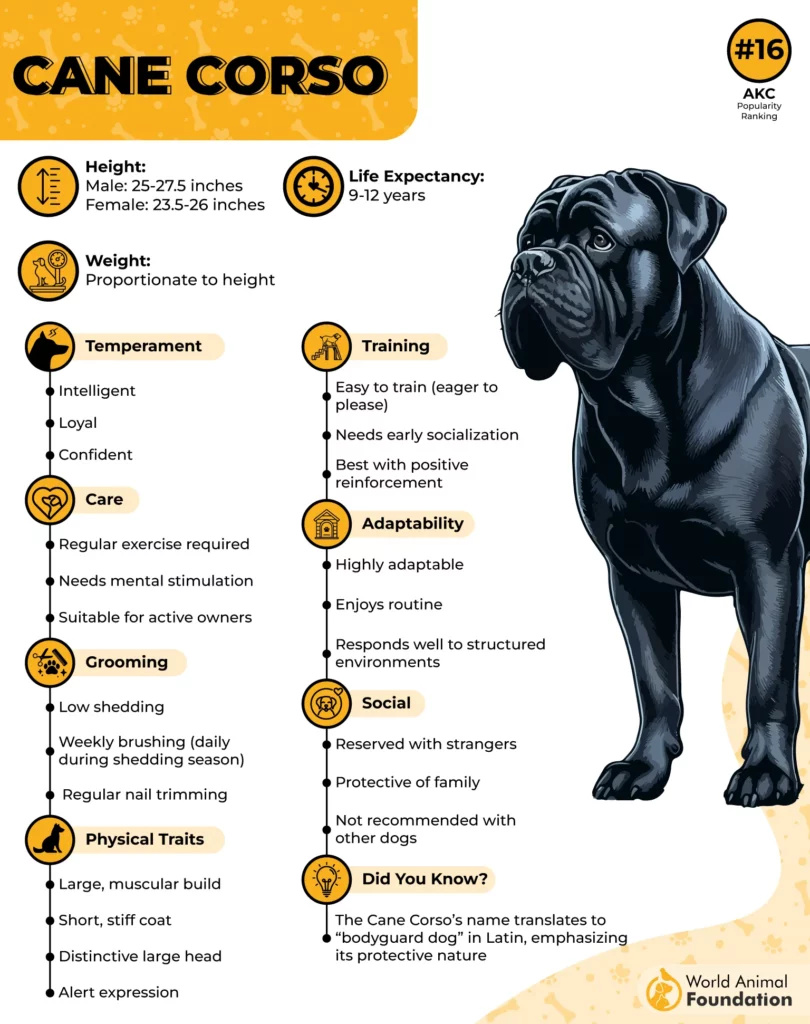
When it comes to guarding, both are fiercely protective, but the Presa tends to be more territorial and naturally suspicious, whereas the Cane Corso is more balanced and trainable in various settings. Physically, the Cane Corso is slightly leaner, built for speed and agility, while the Presa Canario is stockier and more powerful, designed for sheer strength.
Both breeds need consistent leadership, but the Presa Canario can be more challenging to train due to its strong-willed nature. Thinking about getting one? Your experience level and lifestyle should determine which breed is right for you!
|
Feature |
Cane Corso |
Presa Canario |
|---|---|---|
|
Origin |
Italy |
Canary Islands (Spain) |
|
Size & Build |
Leaner, more athletic, built for speed |
Stockier, heavier, built for power |
|
Temperament |
Trainable, eager to please, protective but balanced |
More independent, territorial, and naturally suspicious |
|
Trainability |
Easier to train, responds well to commands |
Requires an experienced handler, more stubborn |
|
Guarding Instinct |
Protective but can be socialized well |
Naturally more territorial and wary of strangers |
|
Energy Level |
High energy, needs plenty of exercise |
Moderate energy but strong endurance |
|
Socialization |
Can adapt well with training |
More challenging, needs early and firm socialization |
|
Lifespan |
9–12 years |
9–11 years |
|
Grooming Needs |
Low maintenance, moderate shedding |
Low maintenance, light to moderate shedding |
|
Best For |
Active families, experienced owners, structured homes |
Experienced handlers, homes needing a serious guard dog |
Cane Corso vs. Presa Canario: Temperament and Behavior
Cane Corso

The Cane Corso isn’t just a guard dog—it’s a protector with a purpose. According to PetMD, this breed is highly intelligent, deeply loyal, and alert. It forms a strong bond with its family and takes its role as a guardian seriously. Unlike other protective breeds, the Cane Corso isn’t needlessly aggressive—it watches, assesses, and acts only when necessary.
But don’t mistake its calm demeanor for passivity. This dog is always tuned in, reading situations with sharp instincts. Training a Cane Corso is both rewarding and necessary. This breed thrives when given structure and clear leadership.
Presa Canario
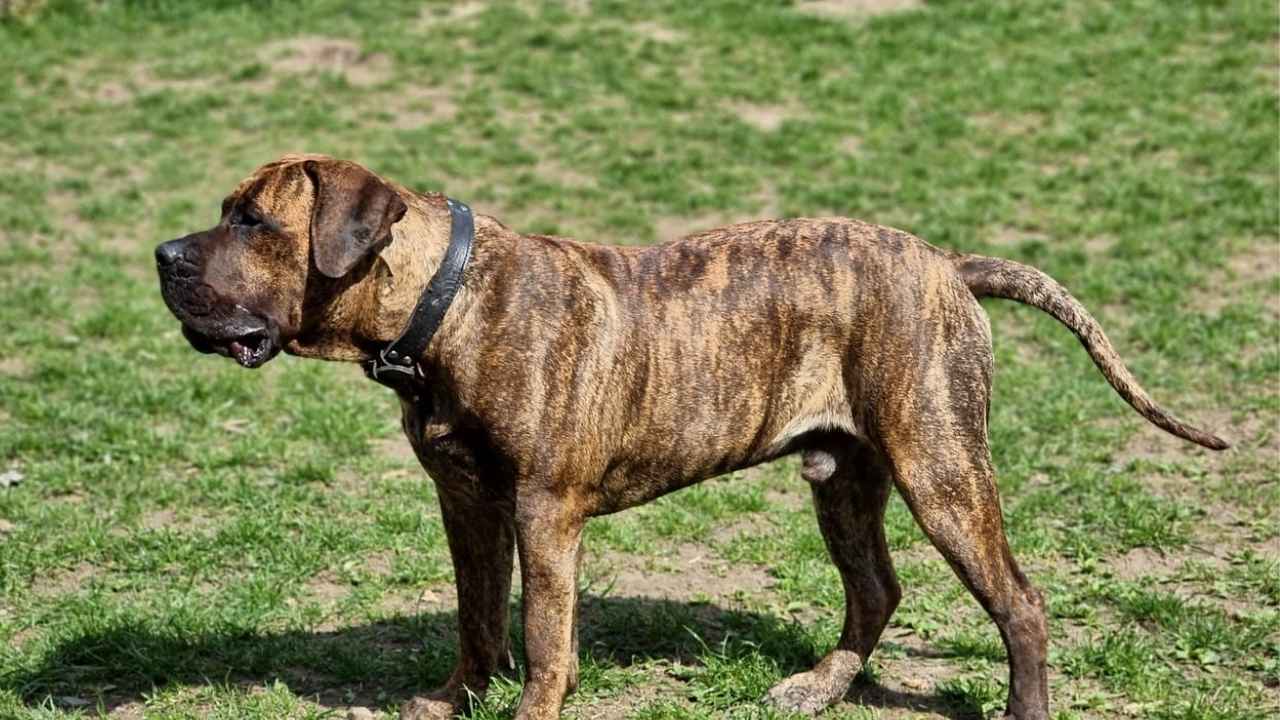
The Presa Canario is a different kind of guardian—bold, confident, and naturally dominant, says AKC. Originally bred for herding and guarding livestock, this breed has strong territorial instincts and a no-nonsense attitude when protecting its home. Unlike the more disciplined Cane Corso, the Presa Canario has an independent streak, making training more challenging. This dog needs an experienced owner who can establish leadership from day one.
Presa Canarios don’t just guard—they take control. If not properly trained, this breed is highly suspicious of strangers and can be more aggressive than a Cane Corso. Their natural dominance means they require firm training and clear boundaries.
Cane Corso vs. Presa Canario: Learning and Development
Cane Corso
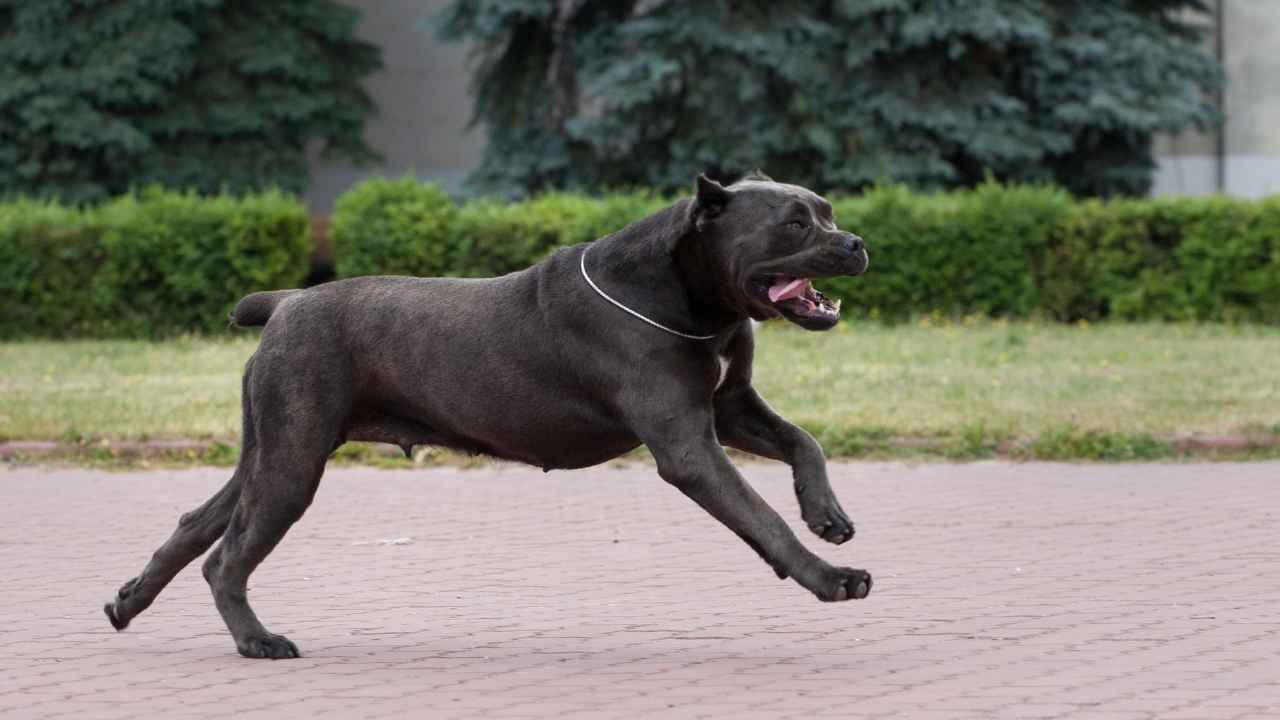
According to the AKC, the Cane Corso is an intelligent breed with a strong desire to work, but that doesn’t mean training is a breeze. This dog is naturally eager to learn, especially when it sees a purpose behind the commands. It responds well to firm, consistent training and positive reinforcement. But here’s the catch—if you’re inconsistent or passive, the Cane Corso will test you.
Early socialization and obedience training are non-negotiable. The Cane Corso has strong protective instincts, and without proper exposure to different people, animals, and environments, it can become overly wary of strangers. Structured training sessions, mental stimulation, and clear boundaries help shape a well-mannered, controlled guardian.
Unlike some working breeds, Cane Corso don’t just blindly obey—they think. This can be both a blessing and a challenge. They pick up commands quickly but may decide whether or not they want to follow them.
Presa Canario
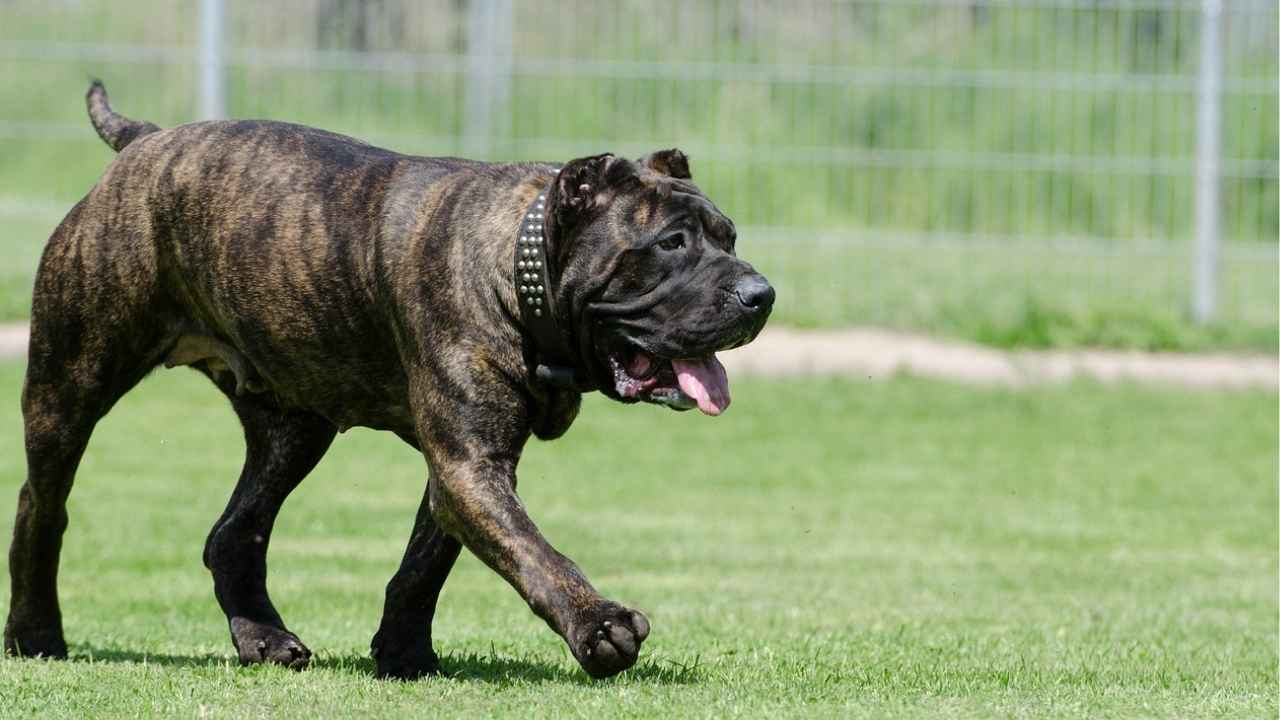
Training a Presa Canario is a whole different ball game. This breed is intelligent, yes, but it’s also extremely independent. Unlike the Cane Corso, which thrives on structured training, the Presa Canario tends to question authority. If it doesn’t respect its owner, it simply won’t listen. This means training a Presa isn’t just about commands—it’s about establishing leadership.
Because of their dominant nature, early training is a must. Without it, a Presa Canario can become unmanageable, territorial, and even aggressive. Socialization is just as critical—this breed needs to be exposed to new people, places, and animals early on to prevent overprotectiveness. But here’s the challenge: Presas don’t naturally seek to please like some breeds do. They require firm, experienced handling with clear, unwavering rules.
Consistency is everything. If a Presa Canario senses weakness or inconsistency in its training, it will push boundaries. They respond best to short, focused training sessions that reinforce respect and obedience.
Cane Corso vs. Presa Canario: Physical Activity
Cane Corso
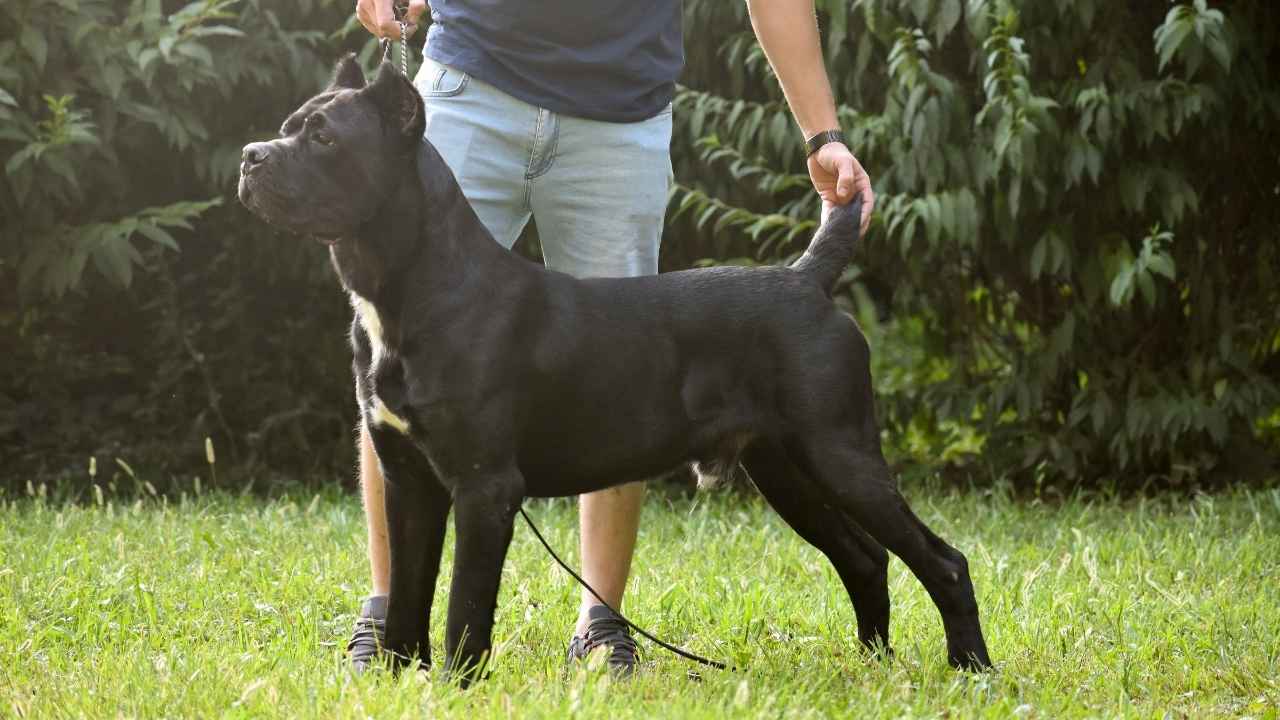
The Cane Corso isn’t just strong—it’s built for action. This breed thrives on daily exercise and needs a combination of mental and physical stimulation to stay balanced. A simple walk around the block? Not even close to enough! According to PDSA, this dog needs two hours of exercise every day, vigorous play sessions, and structured training to burn off energy and maintain its powerful physique.
Cane Corso excel in obedience training, agility work, and even protection sports. They love having a purpose—running alongside their owner, playing tug-of-war, or engaging in advanced training exercises. Without enough activity, they can become restless, destructive, and even develop behavioral issues. Ever seen a bored Cane Corso? Let’s say, your furniture won’t appreciate it.
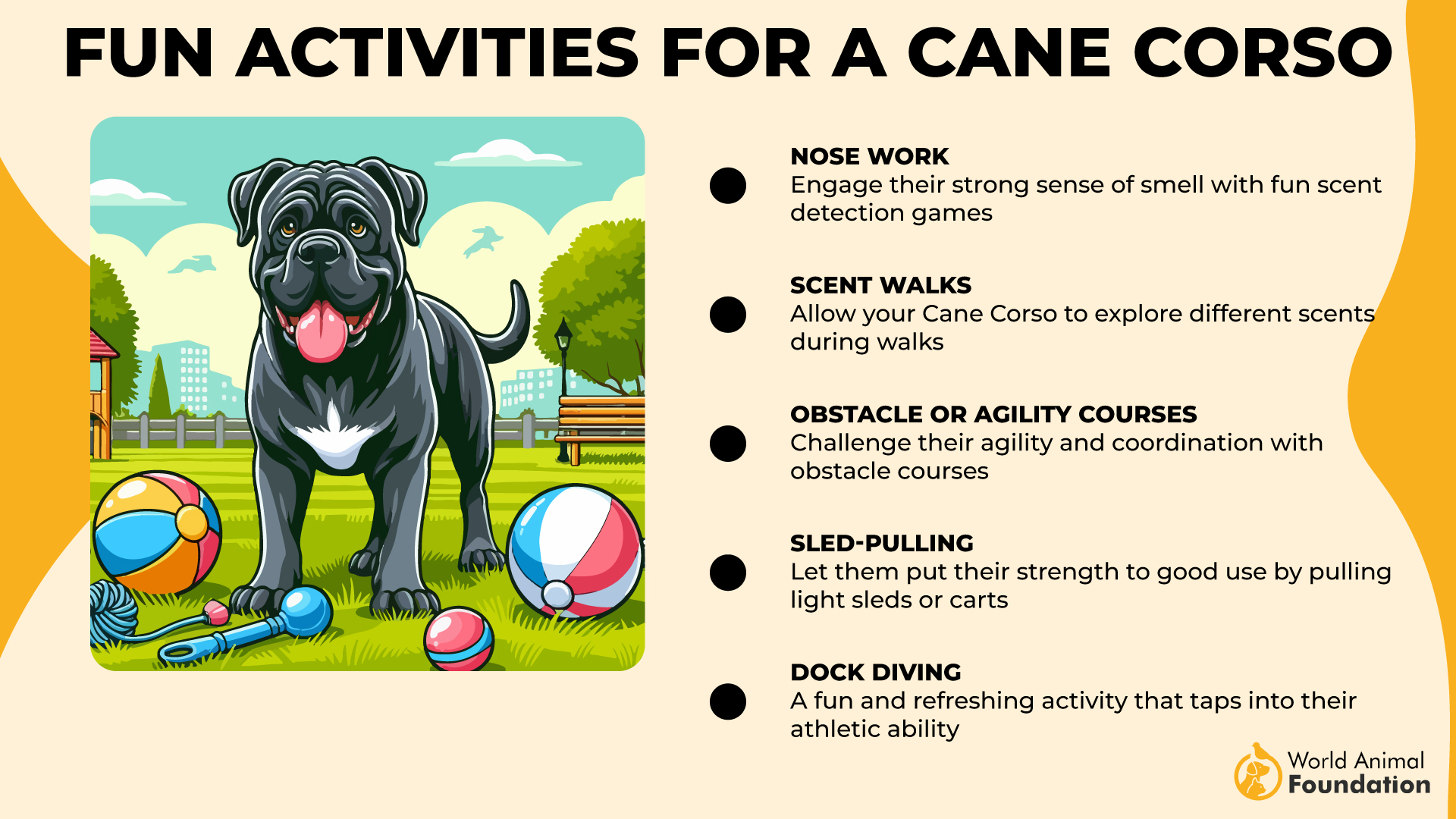
But don’t worry—while they need daily activity, they aren’t hyperactive. A well-exercised Cane Corso is calm and relaxed indoors. The key is structured exercise that engages both their body and mind. Got a large yard? Even better! Include interactive training and bonding activities, not just free play.
Presa Canario
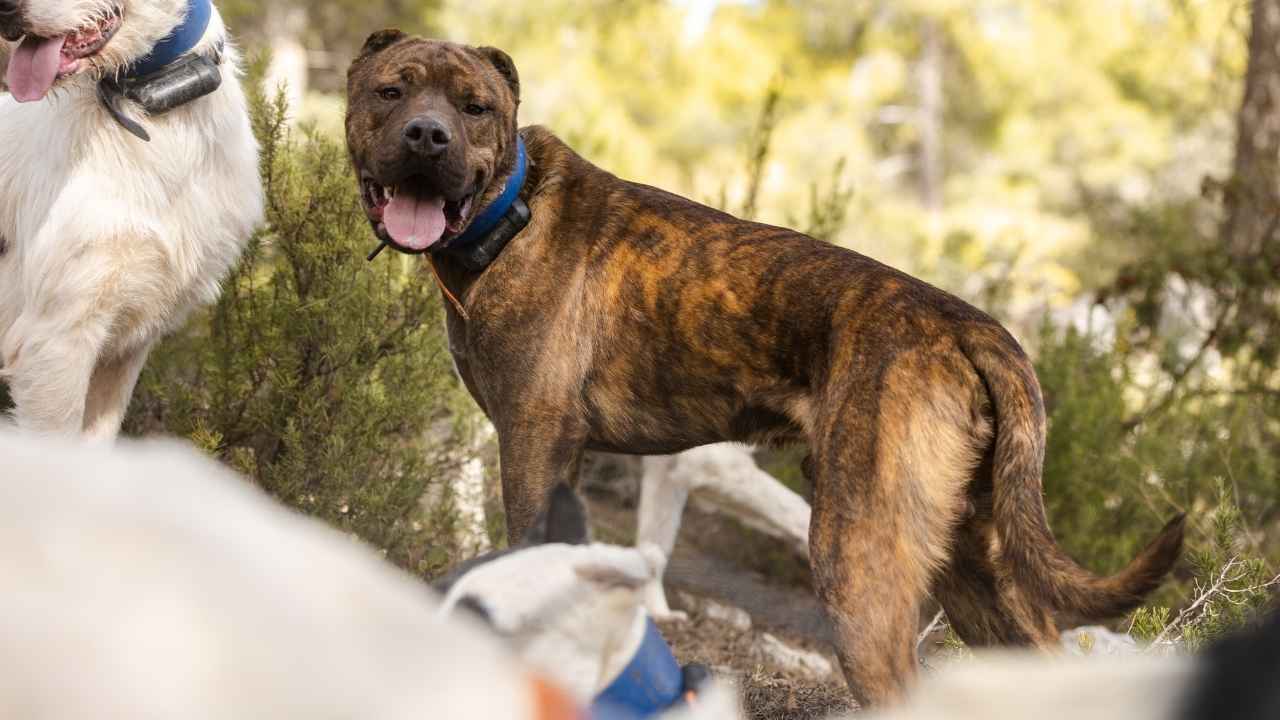
The Presa Canario is another high-energy working breed, but with a slightly different approach to exercise. Presa Canario has a calm appearance and attentive expression, says AKC. Unlike the more structured Cane Corso, the Presa’s natural instincts lean toward endurance and power. Originally bred to guard livestock and cover large areas, this breed thrives on long, purposeful walks, resistance training, and mentally challenging activities.
While they don’t necessarily require agility sports like the Cane Corso, Presa Canarios need daily workouts that reinforce discipline and control. They do well with weighted pulls, structured obedience drills, and controlled play sessions. Unlike some working breeds that settle down after exercise, the Presa Canario tends to stay alert—always watching, always assessing.
Skipping exercise? Big mistake. A bored Presa Canario can develop frustration-based aggression or become destructive. They need a job, whether it’s structured training, personal protection work, or even simple obedience drills. This is not a couch-potato breed! If you’re thinking of getting one, be ready to commit to consistent, daily physical and mental challenges.
Cane Corso vs. Presa Canario: Care and Grooming
Cane Corso
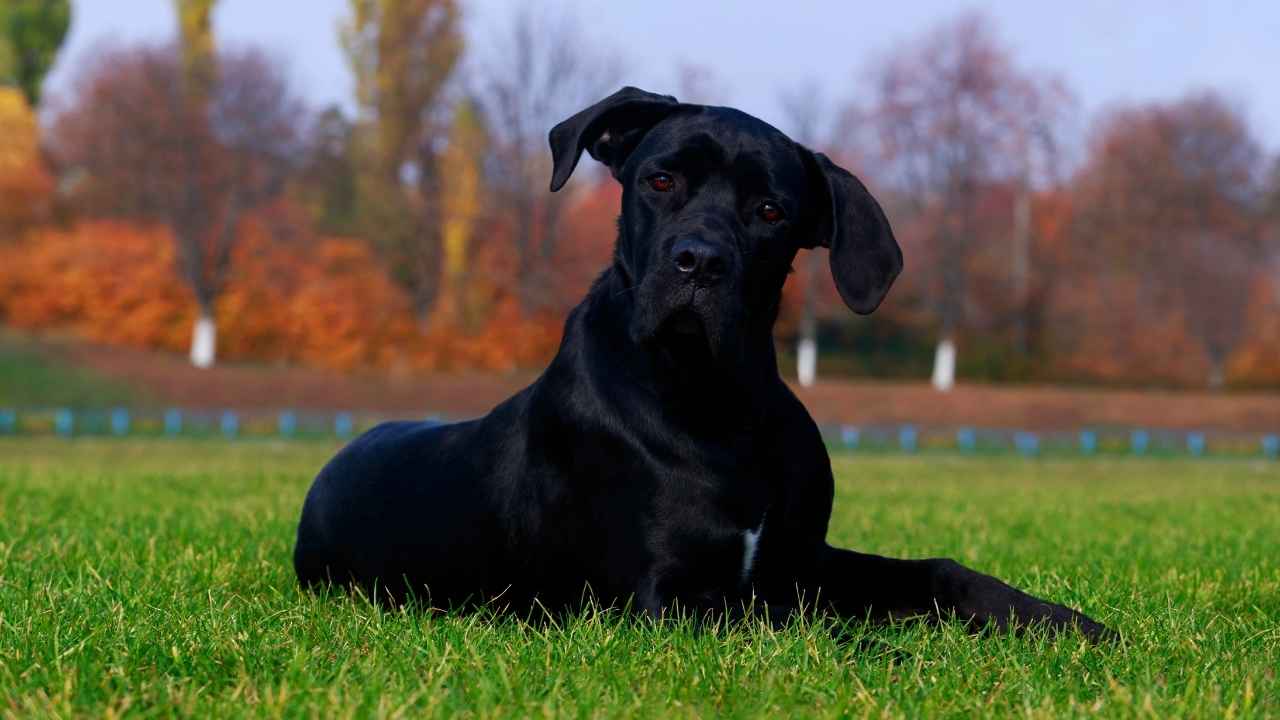
Cane Corso might have a short coat, but don’t let that fool you—this breed still needs regular grooming. Their coat is dense and sheds moderately year-round, with heavier shedding in spring and fall. A good weekly brushing (or twice a week during shedding seasons) with a firm bristle brush or rubber grooming mitt helps keep loose hair under control.
Baths? Not too often! Cane Corso have natural oils that protect their skin, so bathing every 6–8 weeks (or when they get particularly dirty) is enough. Overbathing can cause dryness and irritation. Instead, regular wiping down with a damp cloth can keep their coat looking fresh. And let’s not forget those wrinkles around their face—moisture and dirt can get trapped, so occasional cleaning is necessary.
Nails, ears, and teeth? Non-negotiable! Their nails should be trimmed regularly to prevent cracking, their ears need checking for wax buildup, and dental care is essential. Cane Corso can develop gum disease if oral hygiene is ignored, so regular brushing or dental chews help keep their teeth in top shape.
Presa Canario
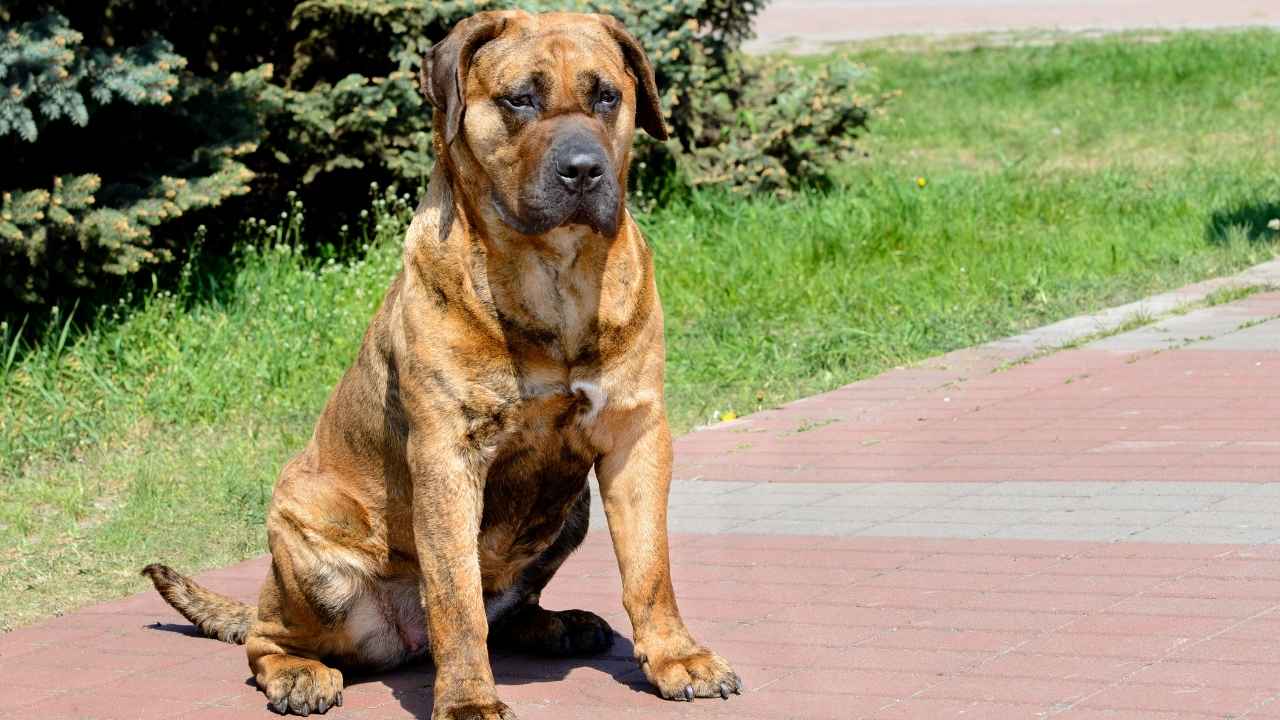
Presa Canarios have a short, coarse coat that is slightly rougher than the Cane Corso’s, making them a bit more resistant to dirt and weather. They shed lightly to moderately year-round, but a weekly brushing session with a deshedding tool or rubber mitt helps remove loose hair and distribute natural oils.
Like the Cane Corso, they don’t need frequent baths—every 6–8 weeks is enough unless they roll in something messy. Their skin can be prone to dryness, so using a mild, dog-friendly shampoo is best. And while their coat may not require much effort, their ears, nails, and teeth definitely do.
Regular ear cleaning prevents infections, nails should be trimmed to avoid overgrowth, and dental hygiene is a must to prevent plaque buildup.
One key difference? The Presa Canario has more sensitive skin. They are more likely to trigger certain types of allergies, says the AKC. Their skin condition requires monitoring and using grooming products when necessary is a smart move. A healthy diet also plays a big role in maintaining their coat’s shine and strength.
Cane Corso vs. Presa Canario: Life Expectancy
Cane Corso

Cane Corso typically live 9 to 12 years, states WebMD, which is pretty solid for a large, powerful breed. But here’s the thing—their lifespan heavily depends on their care. A well-balanced diet, regular exercise, and proactive vet check-ups can push them toward the higher end of the range.
Health issues? They’re prone to hip dysplasia, bloat, and heart conditions, which can shorten their lifespan if not managed properly.
Keeping their weight in check and providing joint supplements can help prevent mobility issues as they age. Early health screenings and a high-quality, protein-rich diet also greatly impact their longevity.
Want your Cane Corso to live a long, healthy life? Focus on mental and physical stimulation, proper training, and regular vet visits. A bored or neglected Cane Corso won’t just become destructive—it can also develop stress-related health issues that impact lifespan.
Presa Canario
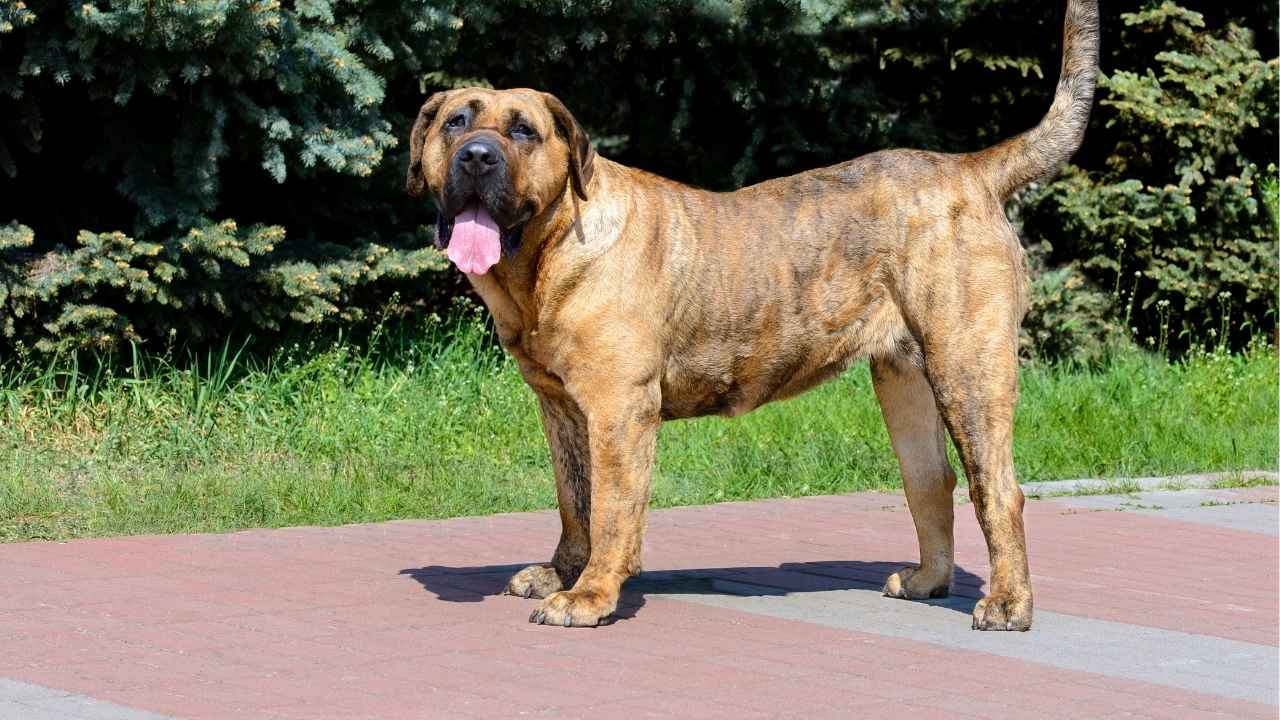
Presa Canarios usually live 9 to 11 years, with some reaching 12 years under optimal conditions. Like the Cane Corso, their lifespan depends on genetics, nutrition, and overall care. A well-exercised, properly fed, and regularly checked Presa has a much better chance of hitting double digits.
Health risks? They’re susceptible to hip and elbow dysplasia, obesity, and bloat, just like the Cane Corso. Since they’re naturally muscular and heavy-set, extra weight can stress their joints, leading to mobility problems in older age. Regular exercise and a diet that supports lean muscle without excess fat are key.
One big factor? Training and socialization. A well-trained Presa is less likely to develop stress-related issues, aggression, or destructive behaviors that could lead to early health concerns. This breed does best with an active lifestyle and regular vet monitoring to keep them strong well into their senior years.
Conclusion
The Cane Corso and Presa Canario are two powerful dogs known for their protective nature, making them excellent choices for a guard dog. Both dog breeds belong to the Molosser group, bred for guarding livestock, herding cattle, and hunting. The Cane Corso dog, also referred to as the Italian Mastiff, is a true working dog with a massive square-shaped head, a black mask, and a short, dense Cane Corso’s coat. The Presa Canario dogs, also called Perro de Presa Canario, originated in the Canary Islands, primarily used for guarding and herding.
When it comes to temperament, training, and socialization, both the Cane Corso breeds and Presa Canario require proper training, early socialization, and ample exercise to ensure they become well-adjusted, properly trained dogs. The Cane Corso training focuses on mental stimulation to control its natural guarding behavior while ensuring it interacts well with other dogs, other animals, strangers, and even small children. Similarly, Presa Canario dogs need responsible ownership and consistent training to manage their aggressive tendencies.
In conclusion, comparing the Cane Corso vs. Presa Canario highlights the strengths of these powerful guard dog breeds. Both breeds are naturally protective, making them excellent for guarding and protection. While the Cane Corso is a loyal and affectionate family dog, the Presa Canario is known for its fearless and determined guarding abilities. Both breeds require properly socialized environments to coexist with other pets and family members.


